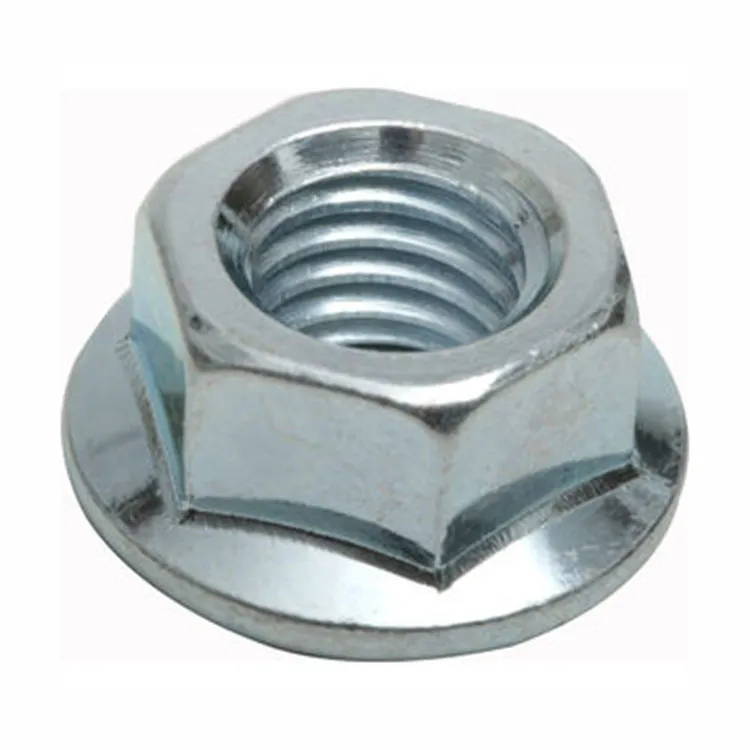DIN 6923 Hex Flange Nuts: The Essential Guide for Enhanced Fastening
2024-10-31
In the realm of fasteners, certain components play a crucial role in ensuring secure, stable, and reliable assemblies, particularly in heavy-duty or high-vibration applications. One such indispensable component is the DIN 6923 hex flange nut. Known for its unique design and exceptional holding power, this nut is widely used across automotive, industrial, and construction sectors for its durability and efficiency.
In this blog, we’ll explore what sets the DIN 6923 hex flange nut apart, its benefits, key applications, and why it’s a preferred choice for engineers and manufacturers worldwide.
What is a DIN 6923 Hex Flange Nut?
A DIN 6923 hex flange nut is a six-sided nut with an integrated, non-spinning flange at the base, which acts as a built-in washer. The DIN 6923 designation follows the German standards for industrial fasteners, ensuring a consistent level of quality and dimensional accuracy. The flange on this hex nut distributes the load over a larger area, reducing the need for a separate washer and minimizing the risk of loosening, particularly in applications subject to vibration or heavy loads.
These nuts are often crafted from steel or stainless steel, though they can be manufactured in a range of materials and finishes based on the specific demands of a project. They are also available with either plain or serrated flanges, each offering different advantages depending on the application.
Key Features of DIN 6923 Hex Flange Nuts
1. Integrated Flange
The flange serves as a built-in washer, helping to evenly distribute the load and reduce stress on the material. This feature also enhances the nut's ability to stay in place, even in applications with high vibration.
2. Serrated Option for Enhanced Grip
Serrated flange nuts offer increased resistance to loosening, as the serrations bite into the material’s surface. This design is ideal for environments where vibrations might otherwise cause traditional nuts to back off. Non-serrated options, on the other hand, are useful when minimal surface damage is desired, like in assemblies where surfaces need to remain unmarred.
3. High Load Capacity
DIN 6923 hex flange nuts are designed to withstand high loads, making them suitable for heavy-duty applications across multiple industries.
4. Corrosion Resistance
With options for stainless steel or other corrosion-resistant materials, these nuts perform well in environments exposed to moisture or harsh elements. Additional coatings, such as zinc plating, can be applied for enhanced protection.
5. Metric Compatibility
Following the DIN standard, these nuts come in metric sizes, ensuring compatibility with metric bolts and studs. This is especially important for applications across regions and industries that adhere to metric specifications.
Benefits of Using DIN 6923 Hex Flange Nuts
1. Enhanced Stability in High-Vibration Environments
The flange on these nuts significantly improves their stability and holding power, making them a reliable choice for machinery, vehicles, and other equipment exposed to constant motion and vibration.
2. Cost-Effective Solution
By eliminating the need for a separate washer, DIN 6923 hex flange nuts streamline the assembly process, reducing both labor and material costs. They provide efficient load distribution with fewer components, which can be beneficial in high-volume production environments.
3. Easy Installation and Removal
The integrated flange design simplifies installation by providing a single unit that acts as both a nut and a washer. This allows for faster assembly and disassembly, particularly in restricted spaces where separate washers might be difficult to maneuver.
4. Increased Surface Protection
With the flange acting as a buffer, these nuts help prevent material damage by distributing pressure more evenly across the surface. This benefit is especially important in softer materials, where concentrated stress from a standard nut could cause damage over time.
5. Versatility Across Applications
Thanks to their durability, load distribution, and resistance to loosening, DIN 6923 hex flange nuts are adaptable to a wide range of applications, from automotive and heavy machinery to building structures and household appliances.
Common Applications of DIN 6923 Hex Flange Nuts
1. Automotive Industry
In automotive applications, where vibrations and jolts are frequent, DIN 6923 hex flange nuts are frequently used to secure components like engine mounts, transmissions, and exhaust systems. The flange’s added grip helps prevent loosening due to constant movement, making these nuts ideal for vehicle assembly.
2. Industrial Machinery
Heavy machinery that operates under continuous movement and intense loads also benefits from the stability and load distribution offered by these nuts. They are used in fastening parts in pumps, compressors, and conveyor systems to ensure longevity and reliable operation.
3. Construction and Infrastructure
In construction, where secure and durable fasteners are essential, hex flange nuts are commonly used to assemble metal frameworks, railings, and other structural elements. They offer resistance to loosening under environmental stresses, contributing to safe and stable assemblies.
4. Electrical and Plumbing Systems
In systems that experience routine maintenance and repairs, such as electrical panels or plumbing fixtures, DIN 6923 nuts allow for quick installation and removal without compromising the integrity of the fastened components.
Tips for Proper Installation of DIN 6923 Hex Flange Nuts
1. Choose the Right Finish
Consider the environment where the nut will be used. Stainless steel or zinc-coated nuts are best for corrosive or outdoor environments, while plain steel may suffice in dry, indoor settings.
2. Use with the Correct Torque
Ensure that the appropriate torque is applied based on the nut’s material and application. Over-tightening can lead to thread stripping, while under-tightening may cause instability.
3. Serrated vs. Non-Serrated
Decide between a serrated and non-serrated flange based on the application’s requirements. Serrated nuts offer better resistance to loosening in high-vibration environments, while non-serrated nuts are preferable when surface preservation is essential.
4. Inspect for Wear and Tear
Regular inspection of fastened components, especially in high-stress applications, helps identify signs of wear. Timely replacement of worn or corroded nuts can prevent failures and prolong the life of the assembly.
Conclusion
The DIN 6923 hex flange nut is a versatile and practical solution for achieving stable, long-lasting fastenings in various applications. Its unique design, combining a hex nut with an integrated flange, provides increased stability, reduced loosening, and efficient load distribution without the need for additional washers. For businesses and industries that rely on robust and reliable fastenings, this type of nut offers both functionality and cost-effectiveness, making it an excellent choice in automotive, industrial, construction, and many other sectors.



